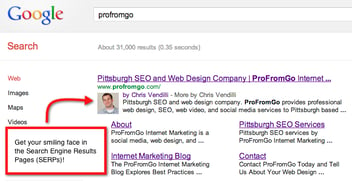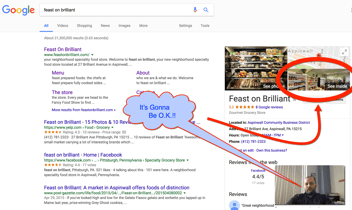 There's one secret to writing for SEO: Don't
There's one secret to writing for SEO: Don't
SEO content is quickly becoming a thing of the past. With Google's advanced algorithms, it's not nearly as imperative today to write for search engines as it was say, 5 years ago. In fact, if you've been listening to what the experts have been saying for years, then you'll know that it's never been a wise idea to write for the search engines - the content almost always comes out sounding like crap.
In fact, that's what the big G has been telling webmasters and SEOs all along: Don't write for the search engines, write for consumers; for real live flesh and blood people. This is the only logical way to operate for 2 primary reasons:
1.) Google's existence as an organic search engine is dependent upon its ability to deliver the most relevant results possible to real users
2.) Only real people - not search bots - can be converted into a sale
If you write for readership and not search bots, you'll end up embedding a significant amount of natural SEO in your content. But in order to produce content that readers will be intrigued by, trust and want to share, you need to learn to write right, and that's not always an easy task for some people. This lens is going to discuss exactly how to:
*Choose a keyword/search term
*Develop a compelling title
*Write a powerful introduction
*Create a body that is interesting and funnels the reader to conversion points
*Craft a conclusion that is more of a "hello, let's get started" than a "thanks for reading, goodbye."
*Professionally edit your work
So if you're developing SEO content, you can still do so, but for our purposes we won't be considering this SEO content - we're considering it readership and authority content, and by the end of this article you'll see why the two are really one and the same.
[photo courtesy of www.unprofound.com]
TABLE OF CONTENTS:
*Choosing a Search Term
*SEO Content: How to Write a Title Right
*Recommended Books for Learning How to Write Right
*Writing an Outline
*Do you write from an outline?
*Writing the Introduction
*How to Write Right: The Body
*Our Articles are an Excellent Example of How to Write Right
*Your final Paragraph is a Summary
*How to Write Right: Editing your Work
Choosing a Search Term
Let's not call it a keyword.
Forget about SEO. Forget about keywords and density and all that garbage that you've been worrying about. Instead, focus on how your readers are going to find your content. If you have to force search terms into a piece of content to get it to work, don't write it. Find out what your readers want from you. If you sell wind turbine parts, find out what your potential clients are searching for related to your product. An article on how to mount a blade assembly? A video showing how to wire a turbine to a battery bank?
Being creative is a must. You have to think about what kind of content you can create that is closely related to your product or service, and build that content around what your consumers are searching for. Programs like Google Adwords keyword tool can help you find the answers. By typing in as many potential search terms and subjects that you can think of, you'll get results that will tell you whether anyone is searching for those terms or not.
However, the one caveat is that you do need to think with a commercial mindset. After all, the ultimate goal with any piece of content is conversions and ROI. Therefore, in the case mentioned above, you can plug you brainstorm right into the search field and hit "go." Enter anything you can think of related to your field, and try to think of yourself as the potential consumer looking for this topic:
how to build a wind generator
wind generator parts
wind turbine parts
diy wind turbine
diy wind generator
living off grid
self sustainable living
wind energy
And so on. Once these and as many other potential search terms that you can think of are entered into your keyword tool of choice, you'll not only get the traffic statistics for the terms you entered, but you'll also get suggestions for other related search terms that people are using in your industry. This data should allow you to quickly select a topic and primary and secondary search phrases that you can focus a piece of content on.
Using a keyword tool is important because it allows you to:
*Get ideas for terms that are actually being used each month
*Get traffic volume, competition and other data for each term
Now, despite the fact that this is the exact process that many SEOs use for keyword research, the fact of the matter is that all efforts were on behalf of the reader and were not done to get any SERP benefits. Finding out what your consumers want and how they're searching for it is one of the most important things you can do for your online business, and it is the first step in learning how to write right.
SEO Content: How to Write a Title Right
The title is your best chance to grab the reader's attention
Writing a title might seem easy, but if it does you're probably not doing it right. Crafting a compelling and concise title takes patience and ingenuity, and in the end you'll probably create 10-20 terrible titles before selecting a gem.
*The primary search phrase must be included
*The title must summarize the content in one very short line
*The title must have an emotional trigger or some other "hook"Don't try to be clever or cute with your title. State exactly what your reader needs to see in order to "consume" the entire piece. If the search phrase data showed that consumers are looking for information on building their own wind turbine, then the simplest title is often the best:How to Build a Wind TurbineSome writers prefer to create their article or other piece of content first and title it later once they have a clear idea of what it's really all about. But most professional writers start with the title and work from there.
 Writing an Outline
Writing an Outline
It's important. Don't skip this step.
If you want to create "SEO content" that sells, you have to learn how to write right, and one of the best ways to do this is to create and work from an outline. Even if you're not an excellent writer, you can create superior content if you work from a focused outline. In fact, an outline can make the difference between a piece that you work on in frustration for days or even weeks, and a piece that you're able to write quickly and effectively because you have clear guidance to do so.
You can start with a basic outline like this:
Title
Introduction - primary point
Supporting point 1
supporting point 2
Subtitle
supporting point 3
supporting point 4
Conclusion
This type of outline is sufficient for an article of 500-750 words. The next step is to fill in the details:
Title - How to Build a Wind turbine
Introduction - primary point: go green, go off grid or save money on utilities by building your own wind turbine
Supporting point 1 - Selecting the right motor for your power generation needs
supporting point 2 - Crafting and assembling the blades
Subtitle - The Housing you use can Make or Break Your Wind Turbine
supporting point 3 - Constructing a durable housing
supporting point 4 - Wiring your system
Conclusion - quality parts and assembly is critical to longevity and power generation
Using even this barely "fleshed-out" outline, you can see how quickly you could write from it simply by following the natural flow of your primary and supporting points to a logical (and hopefully compelling) conclusion.
[photo courtesy of freeimageslive.com]
Do you write from an outline?
Let us know in the comments below.
A few of the world's most renowned writers have admitted to not using an outline to produce their articles or books. Instead, they say they like to use the creative process to "discover" the piece along the way. However, they also admit to sometimes having difficulty finishing a piece, and in other cases by the time they're finished they find the content has taken an entirely different direction than what they set out to accomplish.
What about you? Do you use an outline for your work, or do you prefer to let the creative process guide you?
Writing the Introduction
Other than the title, this is the most important part of your content
Your introduction needs to get immediately to the point and tell the reader exactly what to expect from the piece. If you don't grab your audience and reel them in within the first three sentences, chances are that they'll abandon your content and move on to something else. Ultimately, the first sentence is the most important, so make sure it is high-impact:
Learning how to build your own wind turbine can help you save money, live off the grid and reduce your carbon footprint.
Overall, a good structure for an introduction or opening paragraph is:
First sentence: The Hook - reel 'em in
Second and third sentence (third only if needed) supports the first and follows through to the last:
Fourth sentence summarizes and lays out the expectations of the piece
 How to Write Right: The Body
How to Write Right: The Body
True SEO content value is proven in the body
One of the biggest problems that people cite when trying to create written works is that they lose focus in the body. First of all, this shouldn't happen if a proper outline is used. Second, if each of your paragraphs are focused, then the piece overall will be focused. This means that each paragraph should only focus on one aspect of the subject. All too often people stray within their paragraphs and this makes a piece sound confusing and wandering.
Other than staying focused within a logical procession of paragraphs, there are two other primary keys to writing good body content:
1.) The Power of the Short Word
Never try to sound smart by using large, unnecessary words. If you can say the same thing with fewer words, do so. The power of the short word is severely underestimated by all but the best writers, and it is their compositions that seem effortless to read.
2.) Sentence Cadence
Without sentence cadence, you'll bore your readers to death and sound like a drone. Good content has short sentences and long sentences. There are simple statements and short thoughts. Then there are long statements with conjoining pieces of information; especially items that fall after colons or semi colons.
Writing a good body is as simple as these three steps:
*Focused paragraphs
*Sentence cadence
*Short words
Your final Paragraph is a Summary
Recap and compel to take action...
In your closing paragraph you'll need to quickly recap what was covered in your article and move immediately into your conversion point. This can consist of asking the reader to call for a consultation, to fill out a form, to provide their email address or to read another article. Whatever your conversion point is, if your reader has made it all the way to the end of your content they're now considered a "qualified lead."
So to recap, learning how to write right consists of following these simple procedures:
*Find out what your consumers want and how they are looking for it
*Craft a compelling title with the search term in it
*Write a powerful introduction with a hook and layout of expectations
*Write a body with short words, focused paragraphs and a varied sentence cadence
*Include a summary that recaps and compels the reader to take further action
In your case, that further action is editing, because even the most interesting piece can be absolutely worthless if it is loaded with spelling, syntax, word choice, grammar and other errors.
How to Write Right: Editing your Work
There's only one way to do it right, and you're not going to like it...
Yes, you can use software to check your work for spelling or grammar errors, but in almost all cases these programs miss a significant amount of problems with written content that only a human editor can understand and identify. So while it's okay to use such programs to help keep your work tidy while you're writing, there is only one way to properly edit an article:
You Must Read Every Single Word in a Linear Fashion from Start to Finish
For best results, read it aloud once and you'll catch any extra words or unnatural speech. Then read it silently and you'll be likely to catch any technical issues with the piece.
Ideally, when you write content it should be edited, sent for editing by someone other than the author, and then put away for a few days. Once you pick the piece up again you'll look at it with a fresh set of eyes, which may help pinpoint problem areas. But because most people don't have the time or money to do this, editing every word of your work by hand is the only acceptable method of polishing a professional piece of SEO content. Just remember that the best way to write for SEO is to not write for SEO at all.





